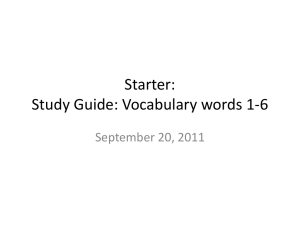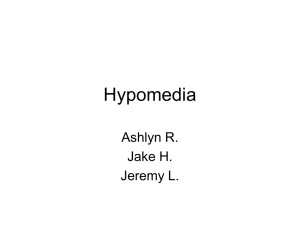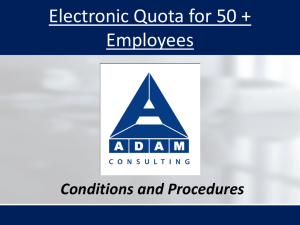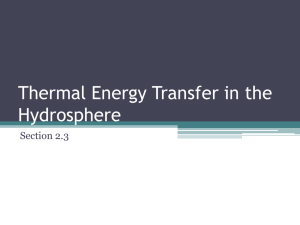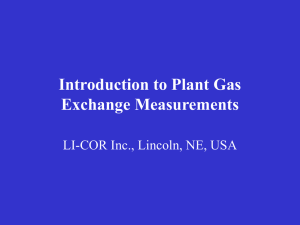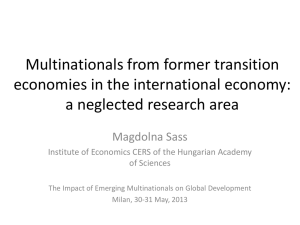Investor Guidebook 2014
advertisement
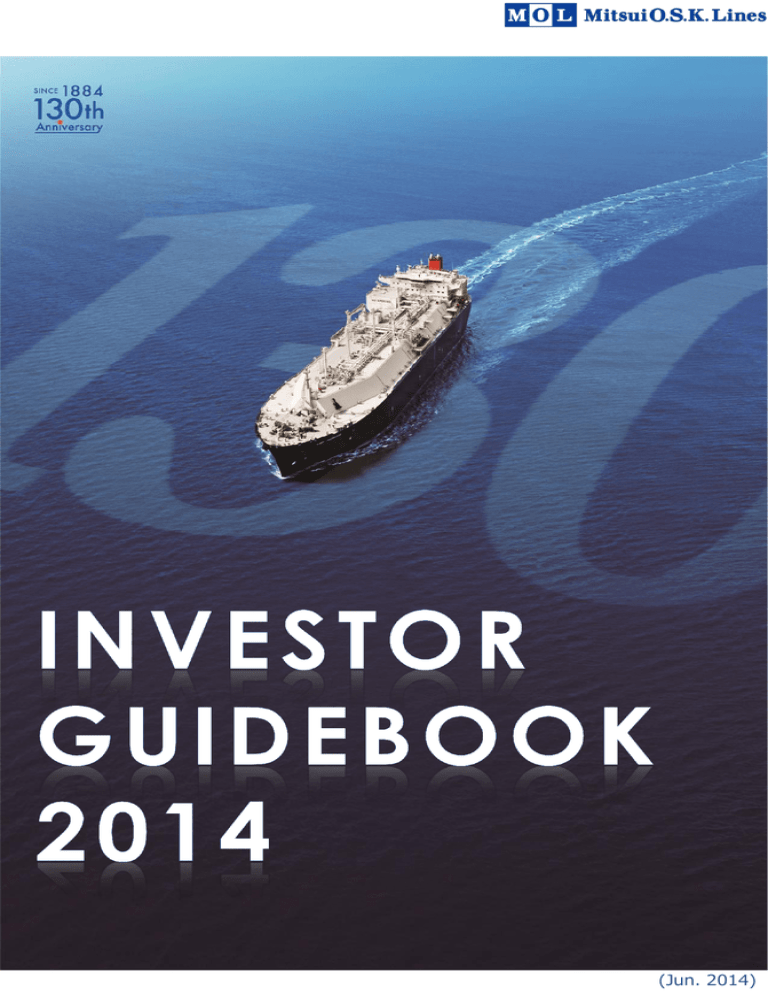
(Jun. 2014) MOL Group Corporate Principles 1. As a multi-modal transport group, we will actively seize opportunities that contribute to global economic growth and development by meeting and responding to our customers’ needs to this new era 2. We will strive to maximize corporate value by always being creative, continually pursuing higher operating efficiency and promoting an open and visible management style that is guided by the highest ethical and social standards 3. We will promote and protect our environment by maintaining strict, safe operation and navigation standards Long-term Vision To make the MOL Group an excellent and resilient organization that leads the world shipping industry 【Contents】 MOL at a Glance ①Highlights of Business Performance 03 ②Strategically Balanced Business Portfolio 05 ③Market Position 07 Midterm Management Plan ①Main Theme/Overall Strategies 09 『STEER FOR 2020』 ②Overall Strategies 10 ③Profit Targets/Financial Targets/Fleet Scale 11 ④Supplements/Reference 12 ①Overall View 13 ②Dry Bulkers 15 ③Tankers 18 ④LNG Carriers・Offshore Business 21 ⑤Car Carriers 23 ⑥Containerships 24 ⑦Ferry & Domestic Transport 27 ⑧Associated Businesses 28 ①Corporate Governance/Compliance 29 ②Safe Operation 30 ③Environment 31 ④Social Responsibility 32 ①Profitability & Efficiency Indices 33 ②Stability Indices 34 ③Cash Flow Indices 35 ④Performance Indices 36 ⑤Financial Statements(Consolidated) 37 Segment Information Management Foundation Financial Data General Information 39 MOL at a Glance ①Highlights of Business Performance P/L Reinforce Cost Competitiveness Exchange Rate & Bunker Price (Fiscal year average) FX Sensitivity(\bn/\/$) Bunker PriceSensitivity(\bn/$/MT) Effect to Ordinary income/loss(\bn) 0.8 0.8 1.1 1.6 2.5 2.2 3.3 3.8 1.7 2 2 0.3 0.3 0.3 0.3 0.3 0.3 0.3 0.3 0.2 0.2 0.2 1.9 2 0.17 0.18 +19 ▲ 10 ▲ 14 ▲ 14 ▲ 15 ▲ 1 ▲ 33 ▲ 94 +12 ▲ 30 ▲ 51 +7 +44 *Maximum estimation Investor Guidebook 2014| 3 MOL at a Glance ①Highlights of Business Performance B/S (Note)”Shareholders’ Equity” refers to : To FY2005: Shareholders ’equity on the consolidated Balance Sheet From FY2006: Owners’ equity plus accumulated gains/losses from valuation and translation adjustments Dividends 【Dividend Policy】 The company recognizes the importance of increasing corporate value through aggressive business investment and returning profits directly to the shareholders through dividends. In the midst of an aggressive investment plan, mainly in vessels, based on our mid-term management plan aiming for further growth, we are seeking to increase our corporate value per share while utilizing internally reserved funds and solidifying our financial position. In consideration of the above issues, the company will use 20% as a guideline for the dividend payout ratio over the coming terms, and pay dividends in conjunction with consolidated performance. However, MOL will address the need to increase the ratio under its mid-and long-term management policies. Investor Guidebook 2014| 4 MOL at a Glance ②Strategically Balanced Business Portfolio Revenue by Segment (Consolidated) Ordinary Income by Segment (Consolidated) Highly Stable Profit Global Major Carriers’ Revenue Composition by Segment Source:MOL internal calculation based on each company‘s published data (Note)①MOL's containerships & related business to include revenues from Containerships, Terminal and Logistics ②NYK's containerships & related business to include revenues from Containerships, Air freighters and Logistics ③A.P.Møller-Mærsk's containerships & related business to include revenues from Terminal business. Investor Guidebook 2014| 5 MOL at a Glance ②Strategically Balanced Business Portfolio Fleet Composition Dry Bulker Composition At the end of Mar.2014 At the end of Mar.2013 vessels vessels k dwt k dwt Capesize 107 20,281 103 19,389 Panamax 38 3,180 38 3,198 67 3,696 68 3,763 56 1,871 52 1,735 6 74 6 74 Wood chip carrier 42 2,229 44 2,296 Steaming coal carrier 40 3,603 41 3,644 Bulk carrier Handymax Small Handy Heavy lifter 47 826 52 828 403 35,760 404 34,928 38 10,866 47 12,925 Product tanker 59 3,394 61 3,515 Chemical tanker 72 2,040 75 2,024 LPG tanker 11 573 11 573 180 16,874 194 19,037 67 5,182 69 5,310 General cargo carrier (Sub total) Tanker Crude oil tanker (Sub total) LNG carrier Offshore(FPSO) 1 - 1 - Car carrier 125 2,033 127 2,063 Containership 119 7,091 115 6,370 40 160 44 159 Cruise ship 1 5 2 10 Others 2 13 3 19 938 67,117 959 Ferry/Domestic carrier Total 67,895 Note) Including spot-chartered ships and those owned by joint ventures Variation of Procurement and Contract terms Market Exposure % by Vessel type Total number Market of Fleet Exposure Capesize 107 28% Mid-and small-size bulkers 161 60% VLCC 34 29% Product Tanker 59 75% LPG Tanker 11 73% *as of Mar.2014 “Market Exposure” Vessels operating under contracts less than two years, which are owned or mid- and long-term chartered vessels. (Includes vessels that combine multiple customers’ cargoes.) Owned/Chartered Ratio(by DWT) Global Major Carriers’ Fleet Composition(by DWT) Source:①World seaborne trade = MOL estimates based on Clarkson data and others ②Fleet composition = MOL estimates based on each company's published data and Clarkson/MDS (Excluding Passenger ship, ferries and tugs) Investor Guidebook 2014| 6 MOL at a Glance ③Market Position Fleet Size of Global Major Carriers (All types of ships) Dry Bulkers Tankers LNG Carriers Car Carriers Investor Guidebook 2014| 7 MOL at a Glance ③Market Position Containerships (by TEU) Containerships:Major Operators/Alliances Share by TEU G6(*1):MOL、APL、Hyundai、NYK、Hapag-Lloyd、OOCL P3 (*2) :Mærsk Line、MSC、CMA-CGM CKYHE (*3) :COSCO、KL、Yang Ming、Hanjin、Evergreen (*1)Expanded cooperation to TP(Asia-USWC) trade in May 2014(AE and TP(Asia-USEC) are now under cooperation) (*2)Service planned to be started in 2014 (*3)Service planned to be started on AE(including Mediterranean region) in April 2014 (Note)The shares of all alliances are calculated by simply adding members’ capacities as of April 2014, and could be different from actual shares after inauguration. Investor Guidebook 2014| 8 Midterm Management Plan”STEER FOR 2020” ①Main Theme/Overall Strategies Main Theme New Midterm Management Plan Main Theme:Solid growth through innovative changes Overall Strategies Innovation in Asset Portfolio by Segments:Innovation Ⅰ・Ⅲ(Business Portfolio / Business Domain) Investor Guidebook 2014| 9 Midterm Management Plan”STEER FOR 2020” ②Overall Strategies Building up Highly Stable Profits:Innovation Ⅰ・Ⅲ 【Highly Stable Profits】 ●Profits that are fixed, or expected to be fixed during this midterm management plan, from contracts of two years or more ●Projected profits from highly stable businesses (The segments included in: Dry bulkers, Tankers, LNG Carriers, Offshore businesses, Associated businesses and Others) 【Investments(FY2014-2019)】 For Building up Highly Stable Profits Downsize Market Exposure(Dry bulker and Tanker):Innovation Ⅱ(Increasing Market Tolerability) Enhance Cost Competitiveness:Innovation Ⅱ 【Investments(FY2014-2019)】 FY2014-2016: For Enhancement Cost Competitiveness JPY 70bn (Major Factors) Reduce fuel cost Reduce unit price and quantity of other cost items Enhance competitiveness through economies of scale Consolidate procurement and suppliers, etc. Investor Guidebook 2014| 10 Midterm Management Plan”STEER FOR 2020” Profit Targets/Financial Targets (\ bn) ③Profit Targets/Financial Targets/Fleet Scale FY2013 FY2016 FY2019 (Result) (Plan) (Target) Reveune Ordinary income/loss (Highly Stable Profits) Net income/loss 1,729 1,900 2,100 55 100 140 (50) (55) (75) 57 80 110 ROA *1 2.4% 4-5% ROE *2 9.5% above 10% *1) Ordinary income ÷ Average Total assets at the beginning and the end of the fi scal year *2) Net income ÷ Average Shareholders' equity at the beginning and the end of the fi scal year Equity ratio *3 Net gearing ratio *4 29% (around FY2019) 35-40% 135% (around FY2019) 100% *3) Shareholders' equity ÷ Total assets *4) (Interesting bearing debt - Cash and cash equivalents) ÷ Shareholders' equity FX(\/USD) Bunker price(USD/MT) Market level 99.79 100 100 610 620 620 Assuming not so much improvements in and after FY2014 Ordinary Income(Loss) by Segments Fleet Scale (number of ships) Bulkships FY2019 (Result) (Plan) (Target) Increse/ Decrease (FY13⇒FY19) 730 780 +1% Dry Bulkers 403 365 365 -9% Tankers 180 160 160 -11% 67 75 120 +79% FPSO/FSRU 1 10 15 Car Carriers 125 120 120 -4% 119 105 105 -12% 43 45 45 +5% 938 880 930 -1% Containerships Total FY2016 776 LNG Carriers Others FY2013 +1400% Investor Guidebook 2014| 11 Midterm Management Plan”STEER FOR 2020” Impact of Shale Revolution Cargo LNG Crude Oil (VLCC) LPG Petroleum Products Chemical Products Coal ④Supplements/Reference ↑Positive Impact ↓Negative Impact Impact Decrease in U.S. LNG imports (net decrease) Increase in U.S. LNG exports (net increase) Increase in ton-miles by growth in cargoes outbound from U.S. Decrease in U.S. crude oil imports (net decrease) Increase in ton-mile by change of crude oil destinations outbound from West Africa Increase in U.S. LPG exports (net increase) Increase in ton-mile by growth in cargoes outbound from U.S. Increase in exports of U.S. petroleum products (net increase) Change in destination of petroleum products from Asia to U.S. Trend toward increase in exports of U.S. chemical products Increase in U.S. coal exports (net increase) ↓ ↑↑ ↑ ↓↓ ↑ ↑ ↑ ↑ ↑↓ ↑ ↑ Scenario for Earnings Recovery in Containership Business 【Ref.】MOL:Where ships are built (by number of ships) (Note1)Including chartered vessels and those owned by joint ventures. Excluding offshore business. (Note2)Ships to be delivered during this mid-term management plan period. Investor Guidebook 2014| 12 Segment Information ①Overall View World Population & Global Seaborne Traffic Seaborne Traffic by Commodity Investor Guidebook 2014| 13 Segment Information ①Overall View Growth of World GDP & Seaborne Traffic by Commodity (Ref.)Ship Prices Investor Guidebook 2014| 14 Segment Information ②Dry Bulkers MOL Dry Bulkers : Revenue Breakdown(Consolidated) Global Seaborne Trade of Major Dry Bulk Cargoes Crude Steel:Global Production by Area Iron Ore:Global Seaborne Trade by Import Area Export Australia→Shanghai: 3,100miles Brazil →Shanghai : 11,000miles Investor Guidebook 2014| 15 Segment Information ②Dry Bulkers Coking Coal: Global Seaborne Trade by Import Area Export Steaming Coal: Global Seaborne Trade by Import Area Export Grain: Global Seaborne Trade by Commodity China:Dependence on Imported Iron Ore Investor Guidebook 2014| 16 Segment Information Vessels Supply ②Dry Bulkers (Source:MOL internal calculation based on IHS-Fairplay) Investor Guidebook 2014| 17 Segment Information ③Tankers MOL Tankers : Revenue Breakdown(Consolidated) (Ref.) Crude Oil Tanker Gasoline Crude Oil Product Tanker Naphtha Refined Oil LPG Carrier Kerosene Jet Fuel LPG Diesel Oil Residual Oil (Heavy Oil, Asphalt) Chemicals Gas Field Methanol Natural Gas Chemical Tanker Methanol Carrier Cooling Down LNG LNG Carrier Oil:Global Demand Investor Guidebook 2014| 18 Segment Information ③Tankers Crude Oil①: Global Seaborne Trade by Import Area Crude Oil②:Global Seaborne Trade from Africa/Latin America to Asia(*) Oman →Dalian : 5,800miles Angola →Dalian : 9,800miles US Gulf →Dalian: 15,800miles Petroleum Products: Global Seaborne Trade by Import Area LPG: Global Seaborne Trade by Export Area Investor Guidebook 2014| 19 Segment Information ③Tankers Chemical Products:Demand Forecast by Product Vessels Supply (Source:MOL internal calculation based on IHS-Fairplay) Investor Guidebook 2014| 20 Segment Information ④LNG Carriers/Offshore Business LNG:Supply/Seaborne Trade LNG:Supply Forecast by Area Japan:Import % of LNG by Nation of Origin Investor Guidebook 2014| 21 Segment Information ④LNG Carriers/Offshore Business FPSO An FPSO (Floating Production Storage and Offloading) is a floating production system that receives fluids (crude oil, water and a host of other things) from a subsea reservoir. FSRU An FSRU (Floating Storage & Regasification Unit) is a floating facility for storing and regasifying LNG, which then pressurized and piped ashore. FSRU(left/image) (photo:GDF Suez) MOL:Signed Long-Term Contracts (as of Apr.2014) LNG Carriers 2013 1 Osaka Gas ex.Australia 2 Osaka Gas ex.Australia 3 Kansai Electric Power ex.Australia 4 Kansai Electric Power ex.Australia 5 Tokyo Gas ex.USA 6 Chubu Electric Power 2016 2017 2018 2019 2020~ (FY) 2015 2016 2017 2018 2019 2020~ (FY) To JAPAN ex.Australia 8 ExxsonMobil ex.Australia 9 ExxsonMobil ex.Australia 10 ExxsonMobil ex.PNG 11 ExxsonMobil ex.PNG 12 SINOPEC ex.Australia 13 SINOPEC ex.Australia 14 SINOPEC ex.Australia 15 SINOPEC ex.Australia 16 SINOPEC ex.Australia 17 SINOPEC ex.Australia 18 Petronet ex.Australia Offshore Businesses 2010 1 Petrobras Brazil 2 Petrobras Brazil 3 Petrobras Brazil 4 Petrobras Brazil 6 GDF Suez 2015 ex.Australia 7 Osaka Gas/Kyushu Electric Power 5 Tullow Ghana 2014 Ghana Uruguay To CHINA To INDIA 2013 2014 FPSO FSRU Investor Guidebook 2014| 22 Segment Information ④Car Carriers Global Car Seaborne Trade Car Export from Japan Car Export from Emerging Countries Investor Guidebook 2014| 23 Segment Information ⑥Containerships MOL Containerships: Breakdown by Trade (FY2013) (*1)Trades from/to North America and Carib, excluding (*2) (*2)Trades from/to Europe (*3)Trades from/to South America and Africa, excluding (*1)(*2) (*4)Intra-Asia(incl. Middle-East) trades, Trades from/to Oceania, excluding (*1) MOL Lifting:Transpacific Trade MOL Lifting:Asia/Europe Trade Investor Guidebook 2014| 24 Segment Information ⑥Containerships Cargo Movements in Major Trades (Transpacific・Asia/Europe・Intra-Asia Trades) Transpacific Trade:Cargo Movements(Eastbound by Export Area) Transpacific Trade:Cargo Movement by Commodity Eastbound Westbound Global Containership Capacity by TEU size range Investor Guidebook 2014| 25 Segment Information ⑥Containerships Greater Alliances (updated in Dec. 2014) 2M G6 TNWA GA CKYHE Ocean3 CKYH (G6)Services started on AE trade in 2012, expanded to TP trade(USEC) in 2013, TP trade(USWC) and Atlantic trade in May 2014 (2M)Service planned to be started in Jan 2015 (CKYHE) Service started on AE(including Mediterranean region) in April 2014 and to be expanded to TP Trade in spring 2015 (Ocean3)Service planned to be started in 2015 Cost Items & Structure:Comparison between Containerships and Bulkships Containerships Loading expenses Bulkships Voyage expenses (Port charge /fuel expense) Voyage expenses(Port /fuel charges) Unloading expenses (Terminal Vessel expenses (Capital expense + crew wages, handling handling or charterage) charge, etc.) charge, etc.) (Terminal Feeder expenses General and administrative expenses Feeder expenses Vessel expenses (Capital expense + crew wages, or charterage) Container expenses(capital) Container expenses(Other than capital) General and administrative expenses Container Terminal Business 8 3* 7 5 ① Tokyo 4 6 Berth Length Area Gantry (m) (1,000 m2) Crane Throughput (1,000 TEU) 2013 2012 2011 684 277 6 733 723 700 Yokohama 300 105 3 145 141 109 Osaka 350 105 2 155 91 32 Kobe 800 258 5 534 542 568 930 704 10 658 798 647 ③ Oakland 336 136 4 236 235 231 ④ Jacksonville 730 647 6 194 161 134 ⑤ Laem Chabang Thailand 300 105 5 842 873 744 ⑥ Cai Mep 590 346 6 644 544 275 750 450 6 to be opened in 2017 1,900 1560 20 to be opened in 2014 ② LA Japan (*)Alliance with Brookfield 2* 1 USA Vietnam ⑦ Hai Phong ⑧ Rotterdam Netherlands Investor Guidebook 2014| 26 Segment Information ⑥Containerships/⑦Ferry & Domestic Transport MOL Group Logistics Business Revenue by Area Revenue by Segment MOL Group’s Share in Long Course Ferry Market in Japan MOL Group Passenger 52% (3 companies*) 48% (FY2012) Cargo Others(5 companies) 57% 43% (FY2012) (*)MOL Ferry Co.,Ltd./ Ferry Sunflower Ltd./ Meimon Taiyo Ferry Co.,Ltd. Source:MOL internal calculation based on JLCFSA Traffic Volume by Long Course Ferry Service Investor Guidebook 2014| 27 Associated Businesses Segment Information ⑧Associated Businesses Real Estate Creating stable profits mainly by Daibiru Corp., the core company in the MOL’s real estate business Cruise Ship Operating cruise ship “NIPPON MARU” Tugboat Expanding businesses in foreign ports in addition to domestic ports Trading Selling fuel oil, Ship equipments (PBCF) and materials, etc. Others Travel agent, Construction, Temporary staffing, etc. Daibiru Corp.:Midterm Management Plan ”Design100” Project Phase-1 Number of Cruise Passengers in Japan MOL Group Tugboat Fleet Scale Sales Results of PBCF(*) Installed with Ships (*)Propeller Boss Cap Fins, jointly developed by MOL and other parties, improve propeller efficiency and produce a 4% to 5% improvement in fuel efficiency. Investor Guidebook 2014| 28 Management Foundation ①Corporate Governance/Compliance MOL Management Foundation Strengthening of management foundation in "STEER FOR 2020" ① Reinforce compliance ② Reconstruct our safe operation structure ③ Strengthen total risk control ④ Concentrating business intelligence ☛for further information http://www.mol.co.jp/csr-e/ MOL’s Philosophy on Corporate Governance MOL aims to maximize stakeholders' profits through the most appropriate allocation of management resources, with higher transparency of corporate management from the shareholders’ viewpoint. This philosophy is set out in the MOL Group Corporate Principles as follows: “We will strive to maximize corporate value by always being creative, continually pursuing higher operating efficiency, and promoting an open and transparent management style that is guided by the highest ethical and social standards.” Corporate Governance Structure (as of Jun.2014) MOL adopts a structure whereby the Board of Directors, with the participation of independent outside directors, supervises and encourages business operations, which are carried out by the president as chief executive officer. The company introduced an outside director system in 2000. Compliance MOL has established its “Rules of Conduct” on the following articles, which the company’s executives and employees must observe, and take every measure to ensure compliance with them both at home and overseas. Rules of Conduct All company personnel must act within the following Rules of Conduct when carrying out their duties. 1.Observe laws and regulations while at all times exercising due caution as a 6.Act with awareness of social responsibilities. good administrator. 2.Respect human rights and refuse to permit discrimination and 7.Actively work to ensure safe operations and protect the environment. 3.Protect confidential information and respect intellectual property rights. 8.Build good relationships based on trust with clients and contractors. 4.Clearly separate official and personal conduct, avoid conflicts of interest. 9.Provide guidance and supervision of these Rules of Conduct by individuals in management positions. 5.Stand firm against antisocial forces. 10.Report and consult on discovering suspected breaches. Investor Guidebook 2014| 29 Management Foundation ②Safe Operation ~Forging Ahead to Become the World Leader in Safe Operation~ Safe Operation Management Structure ☛for further information http://www.mol.co.jp/csr-e/ Nationality Ratio of Seafarers(MOL owned vessel) Developing Highly Skilled Seafarers Worldwide (MOL Training Centers) Making Processes for Realizing Safe Operation Visible MOL has introduced objective performance indicators for measuring safety levels, and also set the following numerical targets, including the Four Zeroes. ① Four Zeroes (an unblemished record in terms of serious marine incidents, oil pollution, fatal accidents and heavy cargo damage) ② LTIF(*1)(Lost Time Injury Frequency): 0.25 or below ③ Operational stoppage time(*2): 24 hours/ship or below ④ 4.Operational stoppage accident rate(*3): 1.0/ship or below (*1)Number of work-related accidents per one million hours worked that resulted in time lost from work of one day or more. Average for all industries (2012) was 1.59; for shipping industry, 1.39; for shipbuilding and repair, 0.77. (Source: 2012 Survey on Industrial Accidents issued by the Ministry of Health, Labour and Welfare). (*2)Expresses the amount of ship operational stoppage time due to accidents per ship per year. (*3)Expresses the number of accidents that result in ship operational stoppage per ship per year. Investor Guidebook 2014| 30 Management Foundation ③Environment The “ISHIN” Project, our concept for the next-generation vessels ☛for further information http://www.mol.co.jp/csr-e/ The Senpaku ISHIN project, our concept for next-generation vessels, is a ground breaking initiative that helps protect the environment in a substantive way by reducing CO2 emissions using feasible technologies. Previously, MOL announced concepts for ISHIN-I, ISHIN-II and ISHIN-III as a series of next-generation vessels. In June 2012, MOL took delivery of EMERALD ACE, a new car carrier equipped with a hybrid electric power supply system, taking a major step toward realizing the company’s ISHIN-I image of future car carriers. Hybrid Car Carrier「EMERALD ACE」 (Delivery Jun.2012) 【The Road to ISHIN: Development Roadmap】 「ISHIN-I/Ⅱ/Ⅲ」employ many technologies. We have created a roadmap for research, development and testing on all component technologies and regularly monitor progress toward early implementation on actual ships. H2 FY2013 Component Technology H1 FY2014 H2 FY2014 - Complete tests on the actual vessels - Complete tank tests of ship model of each type of Prepare to introduce Optimum Trim Operation into - Integrate test results, and tune up the individual trim Optimum Trim vessels Operation - Running trial of the actual vessels operated by MOL actual vessels(developing interface with loading chart of each type of vessels. computer, etc) Waste Heat Recovery(WHR) Examine performance of each devices of WHR from the main Examine actual performance of WHR system on sea Valuate working condition of WHR and effect of bunker trial, and delivery. saving under operation. engine Evaluation of energy efficiency improvement and Power Assist confirmation of proper operation through the onshore Sail demonstration test Diesel Particulated Filter(DPF) system development to reduce PMs in the Consideration of appropriate ship types which can be Study of details on energy efficiency improvement installed and have significant effect in bunker saving - Replace DPF installed on actual vessel with fine-tuned - Continue test for examination of durability of fine- - Develop fine-tuned DPF - Verify the performance of DPF installed in the test engine at MOL Technology Research Center(TRC) one tuned DPF installed on actual vessels (one year) - Continue the performance test at TRC and verify PM - Continue the performance test at TRC and verify PM measuring methods measuring methods exhaust gases Implemented Implementation scheduled Schedule of Environmental Regulations by IMO Global Warming Tackling Regulations EEDI GHG emissions ECA Sox *4 Protection Ballast Water Management Marine Phase 0 2016 2017 2018 Phase 1 2019 2020 Phase 2 Required *2 ECA Environment 2015 Tier Ⅱ Tier Ⅱ Tier Ⅲ Sulfur limit Sulfur limit 3.5% General Sea Areas emissions *5 Convention 2014 General Sea Areas emissions*3 Pollution *1 SEEMP Nox Preventing Air 2013 Sulfur limit 1.0% (Adopted in 2004:not ratified) 0.5% *6 Sulfur limit 0.1% Required?? *7 Minimizing the transfer of invasive aquatic species by shipping *8 Ship Recycling Convention *9 (Guideline adopted in 2011) (Adopted in 2009:not ratified) (*1) EEDI(Energy Efficiency Design Index)is a measure of ships energy efficiency (g/ton-mile). The required EEDI of each Phase is as follows:Phase 0=0%, Phase 1=max 10%, Phase 2=max 20% (Applied to new ships) (*2) SEEMP (Ship Energy Efficiency Management Plan) is required to be drawn up to show optimal measures of operation that should be adjusted to the characteristics of individual ships, and to be kept on board a ship. (Applied to both new and existing ships) (*3) The regulation for reduction of NOx in exhaust gases: TierⅠis applied to ships laid down in 2000~2010, TierⅡ to ships laid down in/after 2011, and TierⅢ to ships laid down in/after 2016. (*4) The existing ECAs (Emission Control Areas) are: ①Within 200 miles off the coast of USA and Canada(NOx/SOx)②The USA Caribbean Sea area(NOx/SOx)③ The Baltic Sea and the North Sea areas (SOx) (*5) The regulations for reduction of SOx contained in fuel oil (Applied to both new and existing ships) (*6) A review in 2018 on the availability of the required fuel oil may conclude to postpone the application to 2025. (*7) The convention to protect the marine environment from transfer of harmful aquatic organisms in ballast water carried by ships. In case where the convention enters into force by the end of 2015 by meeting the following conditions, which is increasingly likely, installation of BWTS becomes mandatory from 2016. (Applied to both new ships and, after certain grace periods, to existing ships) (Conditions) Ratification by not less than 30 countries representing a combined total G/T of more than 35% of the world’s merchant fleet.(As of Jan.2014, 38 countries representing a combined total G/T of 30% have ratified.) (*8) The guideline aimed at minimizing transfer of invasive aquatic species attaching to the bottom of ships, recommending installation of the systems on vessels to keep the bottom clean without marine organisms and other measures. (It remains as a voluntary guideline during the review period.) (*9) This convention prohibits and restricts the fitting and use of treaty-specified hazardous materials, and requires vessels to prepare, record and update inventory lists showing the quantity and location of hazardous materials on ships over a ship's lifetime. The convention enters into force 24 months after the following conditions are met: (Conditions) Ratification by not less than 15 countries representing a combined total G/T of more than 40% of the world’s merchant fleet and an annual ship recycling volume not less than 3% of the combined tonnage of the ratifying countries.(As of Apr. 2014, 1 country has ratified.) Investor Guidebook 2014| 31 Management Foundation Participating in the UN Global Compact ④Social Responsibility ☛for further information http://www.mol.co.jp/csr-e/ MOL became the first Japanese shipping company to participate in the United Nations Global Compact in 2005. 10 Principles of the Global Compact Human Right Principle 1:Businesses should support and respect the protection of internationally proclaimed human rights; and Labour Environment Anti-Corruption Principle 2:make sure that they are not complicit in human rights abuses. Principle 3:Businesses should uphold the freedom of association and the effective recognition of the right to collective bargaining; Principle 4:the elimination of all forms of forced and compulsory labour; Principle 5:the effective abolition of child labour; and Principle 6:the elimination of discrimination in respect of employment and occupation. Principle 7:Businesses should support a precautionary approach to environmental challenges; Principle 8:undertake initiatives to promote greater environmental responsibility; and Principle 9:encourage the development and diffusion of environmentally friendly technologies. Principle 10:Businesses should work against corruption in all its forms, including extortion and bribery. Principles of MOL’s Social Contribution Activities External Recognition General CSR Activities-Related(Including SRI) Selection as a Component in Dow Jones Sustainability Indices Since 2003, MOL has been included in the Dow Jones Sustainability Index (DJSI) Asia Pacific. This designation is reserved for companies meeting international criteria for social responsibility in areas such as environmental protection, human rights, corporate governance, and relationships with stakeholders. The component companies are also expected to demonstrate sustainable business practices. Selection as a Component in FTSE4Good Index FTSE is a global index company owned by the London Stock Exchange. Since 2003, FTSE has included MOL in one of its major indices, the FTSE4Good Global Index, which is a socially responsible investment index. Morningstar Socially Responsible Investment Index (MS-SRI) MOL has been included in the MS-SRI since 2003 for its superior social responsibility. The MS-SRI is composed of stocks that have been selected by Morningstar Japan K.K.. Global 100 Most Sustainable Corporations in the World In 2011, MOL was included among the "Global 100 Most Sustainable Corporations in the World," a listing announced each year by Canadian publishing company Corporate Knights Inc. SMBC Sustainability Assessment Loan In 2013, MOL was the first company to receive a Sumitomo Mitsui Banking Corporation (SMBC) Sustainability Assessment Loan. MOL earned a high rating for timely and accurate disclosure of ESG issues and for its initiatives on sustainability. Safe Operation(Including Recognition of Seafarer Training Program) Certification from DNV for LNG Carrier Seafarer Training Program MOL's LNG Carrier Standard Training Course, which is run in Japan and overseas, acquired certification in 2007 from Det Norske Veritas AS (DNV) for compliance with the LNG carrier crew ability standards advocated by SIGTTO(*). (*)Society of International Gas Tanker & Terminal Operators Ltd. Certification from DNV for Seafarer Education and Training Management Program MOL obtained certification in 2012 in its tanker and LNG carrier operations for its independent seafarer education and training program by DNV. The program received certification for compliance with the Competence Management System (CMS), recognizing its effectiveness. Environmental Related ISO 14001 Certification In 2003, MOL acquired ISO 14001 certification, an international standard for environmental management. Scope: Ship operation activities at sites and Head Office associated with multi-modal logistics/ocean services (except charter vessels on contracts of one year or less) DBJ Environmental Ratings In 2011, MOL became the first company in the ocean shipping industry to acquire the "DBJ Environmental Ratings" from the Development Bank of Japan Inc. (DBJ). MOL received the highest rating from DBJ, which cited MOL's "particularly forwardlooking approaches to environmental consciousness." Carbon Disclosure Leadership Index Commendation In 2012, MOL was commended by CDP, an international not-for-profit organization, as a leader in the disclosure of greenhouse gas emissions and strategies for climate change, based on high scores in the CDP's analysis of its approaches to information disclosure. SMBC Environmental Assessment Loan In 2012, MOL acquired the top rating for a Sumitomo Mitsui Banking Corporation (SMBC) Environmental Assessment Loan, earning recognition as a company whose corporate management reflects deep concern for the environment. Investor Guidebook 2014| 32 Financial Data Assets Turnover ①Profitability & Efficiency Indices ☛refer to P37 for figures Ordinary Income(loss) Margin Net Income(loss) Margin ROE・ROA Investor Guidebook 2014| 33 Financial Data Interest-bearing Debt・Shareholders’ Equity・Gearing Ratio ②Stability Indices ☛refer to P37 for figures Net Interest-bearing Debt・Net Gearing Ratio Total Assets・Shareholders’ Equity・Equity Ratio Cash Paid for Interest・CFs from Operating Activities・Interest Coverage Ratio Investor Guidebook 2014| 34 Financial Data CFs from Operating Activities・CFs from Investing Activities・Free CFs ③Cash Flow Indices ☛refer to P37 for figures Capital Expenditure・Depreciation & Amortization CFs from Financing Activities・Cash & Cash Equivalents at term end Investor Guidebook 2014| 35 Financial Data EPS・Dividend per Share・BPS ④Performance Indices ☛refer to P37 for figures PER・PBR Payout Ratio EV・EBITDA Investor Guidebook 2014| 36 Financial Data ⑤Financial Statements(Consolidated) Financial Statements (10-year summary) (FY) 2005 2006 2007 2008 2009 2010 2011 2012 2013 Mar.2005 Mar.2006 Mar.2007 Mar.2008 Mar.2009 Mar.2010 Mar.2011 Mar.2012 Mar.2013 Mar.2014 Shipping and other revenues 1,173,332 1,366,725 1,568,435 1,945,696 1,865,802 1,347,964 1,543,660 1,435,220 1,509,194 1,729,452 Shipping and other expenses 917,148 1,101,459 1,300,038 1,544,109 1,564,485 1,228,478 1,328,959 1,368,794 1,432,014 1,587,902 52,969 65,699 68,581 74,480 78,155 88,366 77,445 85,624 94,685 83,983 84,388 92,272 100,323 110,302 104,104 98,546 91,300 90,885 92,946 100,458 171,794 172,992 168,073 291,284 197,211 20,939 123,400 -24,459 -15,766 41,092 20,147 27,356 34,806 38,992 31,401 19,996 17,226 17,581 12,304 29,507 2,925 4,888 7,627 8,780 7,959 4,315 5,506 7,957 5,165 9,340 11,764 16,816 16,171 18,198 15,999 5,362 8,174 3,300 - - - - - 3,353 - - - 11,392 16,963 23,846 20,391 28,058 24,102 16,701 19,005 17,442 25,105 15,613 14,562 15,845 18,275 18,065 13,929 14,175 11,371 11,511 13,020 12,583 Equity in losses of affiliates - - - - - - - - 4,935 1,234 FX losses - - - - 4,610 - 4,584 4,440 3,296 174,979 176,502 182,488 302,219 204,510 24,234 121,621 -24,320 -28,568 54,985 6,492 19,286 20,551 34,148 20,272 27,559 11,160 14,022 16,064 36,050 4,165 14,048 13,771 19,485 12,824 15,565 6,359 11,558 12,253 7,094 26,415 7,499 5,185 18,164 27,050 24,017 37,415 23,218 125,434 19,325 20,329 1,652 363 1,741 354 5,513 2,459 664 3,104 6,510 - 1,869 - - - - 10,238 5,468 10,978 6,447 155,057 188,289 197,854 318,202 197,732 27,776 95,366 -33,516 -137,938 71,710 (Year ended) D/A Selling,general/administrative expenses Operating income/loss Non-operating income Interests and dividends Equity in earnings of affiliates FX gains Non-operating expenses P/L Interests Ordinary income/losse Extraordinary profit Gain on sale of fixed assets Extraordinary loss Loss on sale of fixed assets - Loss for impairment Income/loss before income tax - 52,587 61,200 63,041 115,183 65,073 8,078 36,431 9,546 11,324 13,796 1,205 7,570 7,468 5,693 638 3,763 -2,797 -20,814 24,799 -4,525 Minority interests 3,003 5,787 6,403 7,004 5,032 3,211 3,455 3,761 4,783 5,045 98,261 113,731 120,940 190,321 126,987 12,722 58,277 -26,009 -178,846 57,393 2,364,695 Net income/loss 1,232,252 1,470,824 1,639,940 1,900,551 1,807,079 1,861,312 1,868,740 1,946,161 2,164,611 Current assets 299,835 340,355 405,473 506,077 428,597 352,030 344,443 386,936 514,246 533,639 Tangible fixed assets 665,319 769,902 847,660 1,047,824 1,106,746 1,209,175 1,257,823 1,293,802 1,303,967 1,379,244 1,581,146 Total assets 874,279 978,019 1,018,951 1,148,898 1,112,058 1,125,609 1,128,493 1,228,252 1,545,118 Current liabilities 429,695 433,022 482,810 528,390 440,909 355,185 374,268 322,851 425,725 430,045 Interest-bearing debt 514,131 571,429 569,417 601,174 702,617 775,114 724,259 869,619 1,046,865 1,094,081 298,258 424,460 550,763 679,315 623,715 659,508 660,795 637,422 535,422 679,160 287,229 380,441 480,091 639,844 727,131 719,532 767,380 732,402 550,714 605,768 182,143 275,688 375,443 536,096 623,626 616,736 664,645 629,667 447,829 502,833 80,230 8,838 20,369 23,291 -71,038 -40,055 46,970 -129,298 -25,285 -25,615 CFs from operating activities[a] 167,896 163,914 156,418 283,359 118,984 93,428 181,755 5,014 78,955 94,255 CFs from investing activities[b] -87,666 -155,076 -136,049 -260,068 -190,022 -133,483 -134,785 -134,312 -104,240 -119,870 95,105 169,626 143,376 286,973 210,108 158,918 143,579 152,151 120,886 169,028 B/S Total liabilities Shareholders' equity *1 Ownes' equity Retained earnings C/F Free cash flows : [a]+[b] Capital Expenditure *2 Ordinary income margin 14.9% 12.9% 11.6% 15.5% 11.0% 1.8% 7.9% -1.7% -1.9% 3.2% Return on assets(ordinary income) 15.7% 13.1% 11.7% 17.1% 11.0% 1.3% 6.5% -1.3% -1.4% 2.4% 1.05 1.01 1.01 1.10 1.01 0.73 0.83 0.75 0.73 0.76 224,763 238,691 236,654 365,764 275,366 109,305 200,845 61,165 78,919 125,075 11.14 Assets turnover EBITDA *3 5.7 6.1 8.8 5.4 4.3 13.6 6.1 20.3 15.6 11.8 10.8 8.2 15.9 8.6 6.4 16.2 0.5 6.2 7.2 37.8% 31.5% 24.8% 30.9% 19.5% 2.0% 8.8% -4.0% -30.5% 9.5% EV/EBITDA Indices - Income taxes-deferred Income taxes-current Interest coverage ratio ROE *4 ROA *5 Gearing ratio *6 Net gearing ratio *7 Equity ratio EPS(¥) Shareholders' equity per share(¥) per share (\ mm) 2004 8.8% 8.4% 7.8% 10.8% 6.9% 0.7% 3.1% -1.4% -8.7% 2.5% 172% 135% 103% 88% 113% 118% 110% 136% 196% 161% 157% 120% 94% 79% 99% 105% 100% 123% 158% 135% 24.2% 28.9% 33.6% 35.7% 34.5% 35.4% 35.4% 32.8% 24.7% 28.7% 81.99 94.85 101.20 159.14 106.13 10.63 48.75 -21.76 -149.57 47.99 248.40 354.01 459.55 567.74 521.23 551.70 552.83 533.27 447.76 567.90 Dividend per share(¥) 16 PER(at fiscal year-end) 8.40 PBR(at fiscal year-end) Payout ratio(consolidated) Cash flows per share(¥) Number of shares issued and outstanding at year-end *8 18 20 8.39 2.77 19.5% 31 12.92 7.57 31 4.53 3 10 63.12 9.83 2.25 2.85 2.12 0.92 1.22 0.87 19.0% 19.8% 19.5% 29.2% 28.2% 20.5% 5 0 5 NM NM 8.38 0.68 -23.0% 0.69 0% 0.71 10.4% 140.6 137.1 130.9 236.8 99.4 78.2 152.0 4.2 66.0 78.8 1,194,452,839 1,195,151,121 1,195,295,415 1,196,526,410 1,196,629,561 1,195,407,722 1,196,043,380 1,196,052,230 1,196,067,835 1,195,955,286 *1 FY2005: Shareholders' equity / After FY2006: "Owners' equity" + "accumulated gains/losses from valuation and translation adjustments" *2 The actual amount calculated by deducting proceeds from the sale of vessels when delivered from “tangible/intangible fixed assets increased” *3 "Operating income"+"Depreciation and amortizaion" *4 Net income / Average shareholders' equity at the beginning and the end of the fiscal year *5 Net income / Average total assets at the beginning and the end of the fiscal year *6 Interest-bearing debt / Shareholders' equity *7 (Interest-bearing debt- cash&cash equivalents) / Shareholders' equity *8 Excluding "Treasury shares" Investor Guidebook 2014| 37 Financial Data ⑤Financial Statements(Consolidated) Segment Information(10-year summary) (\ mm) revenues assets increased tangible/intangible fixed D/A Assets Ordinary income/losse Shipping and other (FY) 2004 2005 2006 2007 2008 2009 2010 2011 2012 2013 Bulkships 596,638 676,322 787,039 1,024,797 998,542 721,725 790,572 726,011 731,269 836,408 Containerships 399,140 488,232 568,590 686,828 639,694 466,378 586,649 542,426 606,588 713,503 Logistics 58,019 63,685 55,570 61,236 56,270 - - - - - Ferry/Domestic transport 45,350 46,771 49,848 53,099 54,534 50,815 50,089 52,134 54,285 55,603 Associated businesses 66,616 87,453 99,669 108,859 107,033 99,795 108,447 106,709 109,649 116,599 Others 7,566 4,259 7,716 10,875 9,727 9,250 7,901 7,939 7,401 7,338 Consolidated 1,173,332 1,366,725 1,568,435 1,945,696 1,865,802 1,347,964 1,543,660 1,435,220 1,509,194 1,729,452 Bulkships 115,078 135,346 163,580 277,570 213,345 66,986 70,837 -6,921 -24,799 57,121 Containerships 55,557 37,485 3,150 6,882 -21,329 -56,878 38,853 -29,910 -11,291 -14,553 Logistics 907 2,050 2,256 2,215 822 - - - - - Ferry/Domestic transport 183 -102 19 497 -888 -2,340 -565 -533 1,282 2,236 Associated businesses 4,987 12,519 13,073 13,812 12,976 9,712 10,676 9,098 10,745 11,146 Others 1,958 2,649 3,026 5,005 2,767 1,263 3,361 4,303 2,449 4,576 Adjustment -3,694 -13,445 -2,618 -3,765 -3,183 5,490 -1,542 -356 -6,954 -5,541 Consolidated 174,979 176,502 182,488 302,219 204,510 24,234 121,621 -24,320 -28,568 54,985 Bulkships 552,153 695,797 817,316 989,607 910,659 1,008,724 1,173,526 1,194,813 1,298,682 1,501,313 Containerships 158,551 225,213 271,484 352,856 362,536 357,412 386,911 365,975 403,166 449,725 Logistics 43,766 55,342 56,714 55,960 47,053 - - - - - Ferry/Domestic transport 44,954 50,128 50,049 50,686 42,664 42,721 38,407 36,089 36,420 35,088 Associated businesses 296,230 307,881 300,113 290,991 293,066 315,924 342,748 355,341 379,969 386,851 Others 260,246 334,892 360,501 412,947 376,655 376,316 317,865 278,060 303,649 325,937 Adjustment -123,651 -198,431 -216,239 -252,498 -225,556 -239,786 -390,718 -284,118 -257,276 -334,220 Consolidated 1,232,252 1,470,824 1,639,940 1,900,551 1,807,079 1,861,312 1,868,740 1,946,161 2,164,611 2,364,695 Bulkships 36,646 41,040 41,706 46,828 48,949 54,612 50,509 58,370 66,689 55,545 Containerships 5,448 10,505 11,820 13,523 15,398 17,778 11,776 13,433 14,900 15,014 Logistics 1,250 1,439 1,468 1,537 1,413 - - - - - Ferry/Domestic transport 2,935 3,384 3,578 3,365 3,948 5,231 4,255 3,866 3,530 3,302 Associated businesses 3,731 6,515 6,416 6,225 6,033 8,640 9,049 8,254 7,963 8,622 Others 2,898 2,916 3,320 2,775 2,156 1,921 1,604 1,446 410 326 Adjustment 59 -102 270 224 256 183 250 252 1,190 1,171 Consolidated 52,969 65,699 68,581 74,480 78,155 88,366 77,445 85,624 94,685 83,983 Bulkships 71,190 119,485 109,856 198,809 154,274 146,949 136,262 158,188 128,440 140,188 Containerships 18,902 37,912 30,327 80,485 36,640 30,592 38,604 8,209 11,462 28,510 Logistics 961 1,236 908 716 971 - - - - - Ferry/Domestic transport 728 8,204 4,387 10,452 1,082 1,131 1,316 829 1,101 1,424 Associated businesses 16,501 7,251 8,285 9,736 26,643 24,374 41,187 5,442 20,339 10,484 Others 3,621 3,135 110 3,401 3,562 1,180 2,342 2,768 621 145 Adjustment - - - -28 32 -37 730 289 2,924 5,395 Consolidated 111,905 177,226 153,876 303,573 223,208 204,190 220,443 175,726 164,890 186,148 (Note)Logistics segment has been integrated into Containerships segment since FY2009. Quarterly Segment Information (two years) (\ mm) (FY) 2012 revenues Ordinary income/losse Shipping and other (Quarter) Full-year 2013 Q1 Q2 Q3 Q4 Q1 Q2 Q3 Q4 Bulkships 188,891 180,395 172,726 189,257 731,269 193,917 205,866 208,808 227,817 Full-year 836,408 Containerships 148,393 154,522 146,298 157,375 606,588 174,682 181,216 176,194 181,411 713,503 Ferry/Domestic transport 12,754 14,609 14,228 12,694 54,285 13,241 14,473 14,358 13,531 55,603 Associated businesses 27,063 26,856 27,552 28,178 109,649 28,294 29,718 28,993 29,594 116,599 Others 1,745 1,738 1,718 2,200 7,401 1,788 1,978 1,780 1,792 7,338 Consolidated 378,850 378,118 362,522 389,704 1,509,194 411,924 433,251 430,134 454,143 1,729,452 Bulkships ▲ 2,301 ▲ 8,603 ▲ 7,223 ▲ 6,672 ▲ 24,799 12,614 11,384 13,788 19,335 57,121 Containerships ▲ 2,470 ▲ 172 ▲ 7,400 ▲ 1,249 ▲ 11,291 ▲ 1,106 ▲ 2,669 ▲ 7,269 ▲ 3,509 ▲ 14,553 Ferry/Domestic transport ▲ 264 996 822 ▲ 272 1,282 ▲ 17 1,229 769 255 2,236 Associated businesses 2,974 2,769 2,982 2,020 10,745 2,907 2,856 3,212 2,171 11,146 Others 542 408 908 591 2,449 1,593 369 2,161 453 4,576 Adjustment ▲ 18 ▲ 654 905 ▲ 7,187 ▲ 6,954 ▲ 699 ▲ 2,773 ▲ 1,381 ▲ 688 ▲ 5,541 Consolidated ▲ 1,538 ▲ 5,255 ▲ 9,006 ▲ 12,769 ▲ 28,568 15,291 10,397 11,281 18,016 54,985 Investor Guidebook 2014| 38 MOL General Information 【History】 Expansion into new transport business, Delivery of innovative ships/M&A/Alliance, Pool company/Management reforms, others 1884 1930 1939 1942 1961 1964 1965 1968 Osaka Shosen Kaisha(OSK Line) is founded. The high-speed cargo ship KINAI MARU is launched, and covers the Yokohama-NYC route in 25 days and 17.5 hours, well below the industry average of 35 days. The ARGENTINA MARU and BRASIL MARU are built as cargo/passenger liners on the South America route, which represent the state-ofthe-art in Japanese shipbuilding at the time. Mitsui & Co., Ltd. spins off its Shipping Department to create Mitsui Steamship Co., Ltd. World's first automated ship, the KINKASAN MARU, with an engine room operated entirely from the bridge, is launched. Japan's shipping industry undergoes a major consolidation, with mergers creating six companies; Mitsui O.S.K. Lines(MOL) by a merger of OSK Lines/Mitsui Steamship, Japan Line(JL) by a merger of Nitto Shosen/Daido Kaiun, Yamashita-Shinnihon Steamship(YSL) by a merger of Yamashita Kisen/Shinnihon Kisen. Japan's first specialized car carrier, the OPPAMA MARU, is launched. 1982 MOL, JL, and YSL launch the full containerships AMERICA MARU, JAPAN ACE, and KASHU MARU, respectively, on the Japan-California route. MOL enters methanol transport business. 1983 LNG carrier, the SENSHU MARU, is launched, and MOL enters LNG transport business. 1984 MOL expands into product tanker business. 1985 The container terminal company TraPac, Inc. is founded in Los Angeles. Double-stack container train(DST) operations begin from Los Angeles. 1989 Navix Line is established by the merger of JL and YSL. Japan's first full-fledged cruise ship, the FUJI MARU, is launched, ushering in the era of leisure cruises in Japan. MOL acquires a share in LNG carrier operator BGT (BGT becomes an MOL consolidated subsidiary in 1998). 1990 MOL acquires a share in forwarder J.F. Hillebrand of Germany / MOL takes over the logistics company Wassing of the Netherlands. 1991 MOL acquires a share in Gearbulk, a Norwegian open-hatch bulker operator. 1993 Crew training school is established in Manila. 1994 A series of the mid-term management plans calling for “Creative Redesigning” begin. 1995 Container route service through a strategic international tie-up called The Global Alliance (TGA), begins. The first double hull VLCC the ATLANTIC LIBERTY, is launched. 1996 MOL acquires a share in chemical tanker operator Tokyo Marine(becomes a consolidated subsidiary of MOL). 1998 The New World Alliance (TNWA) is inaugurated. 1999 New Mitsui O.S.K. Lines is established by the merger of MOL and Navix Line. MOL (Japan) Ltd. is established. 2000 Corporate governance system is reformed; introduce executive officer system and invites outside directors. MOL Environmental Policy Statement is established. 2001 MOL Group Corporate Principles is issued. 2004 Mid-term management plan MOL STEP, with the main theme of “Growth” starts. Daibiru Corporation becomes a consolidated subsidiary of MOL. 2005 MOL forms a strategic tie-up with Kintetsu World Express. 2006 Utoc Corporation becomes a consolidated subsidiary of MOL. MOL Formulates Measures to Reinforce Safe Operation Structure with the Slogan "Returning to Basics", addressing four marine incidents with utmost seriousness. 2007 Mid-term management plan MOL ADVANCE, with the main theme of “Growth with Enhanced Quality” starts. The world's largest iron ore carrier, third-generation BRASIL MARU is launched. 2009 MOL forms the concept for its next generation vessels "ISHIN "Series. Japan’s first Shuttle and Regasification Vessel(SRV) the GDF SUEZ NEPTUNE is launched. 2010 Mid-term management plan GEAR UP! MOL, with the main theme of “Challenge to Create New Growth ” starts. MOL signs a contract for long-term charters of LNG vessels by ExxonMobil, which are planned to be built in China. The first participation in FPSO chartering for Petrobras, the Brazilian national oil company. 2011 Support Activities by MOL cruise ship and ferry in areas stricken by the Great East Japan earthquake and Tsunami. The G6 Alliance is inaugurated in Asia/Europe trade by TNWA and GA(Grand Alliance). The LR1 product tanker pool management company “Straits Tankers” is founded. The VLCC pool management company “Nova Tankers” is founded. MOL wins orders for Indonesia's 1st Coastal LNG Transport Project. 2012 World's first Hybrid car carrier Emerald Ace is launched. MOL receives EVO's Top Award for Container Service. *Eigen Verladers Organisatie(EVO) 2013 Business Structural Reforms executed; Transferred sales and vessel operations of the dry bulker fleet (over 130 vessels) to Singapore. The single-year management plan "RISE 2013“, with the target of absolutely achieving profitability in FY2013. G6 Alliance expands cooperation to Transpacific(Asia/USEC) trade. Japan’s first participation in FSRU project (Build and charter world's largest FSRU in Uruguay) . The chemical tanker pool management company “Milestone Chemical Tankers” is founded by Tokyo Marine. 2014 Mid-term management plan STEER FOR 2020, with the main theme of “Solid growth through innovative changes” starts. MOL forms a strategic alliance with Brookfield, aimed at enhancing and expanding MOL's container terminal business. G6 Alliance expands cooperation to Transpacific(Asia/USWC) and Transatlantic trades. MOL signs the first contract for a LNG carrier to transport shale gas from USA to Japan (for Tokyo Gas). Investor Guidebook 2014| 39 MOL General Information (Ref.)Major Consolidation Apr.1, 1964 Major Consolidation Mitsui Steamship 1999 Mitsui O.S.K. Lines Mitsui O.S.K. Lines Osaka Shosen Kaisha Yamashita Steamship Yamashita-Shinnihon Steamship 1989 Shinnihon Steamship Navix Line Nitto Shosen Japan Line Nippon Liner System Daido Kaiun Kaisha Nippon Yusen K.K. Nippon Yusen K.K. Nippon Yusen K.K. 1991 Mitsubishi Shipping 1998 Nippon Oil Tanker Showa Line Nissan Kisen Kaisha Kawasaki Kisen Kaisha Kawasaki Kisen Kaisha Iino Kaiun Kaisha Kawasaki Kisen Kaisha Iino Kisen Credit Ratings (as of Jun.2014) Credit Agency Type of Rating Rating JCR Long-term senior debt(issuer) rating A R&I Issuer rating A- Moody's Issuer rating Baa3 ☛for latest information http://www.mol.co.jp/ir-e/stock_e/rate_e.html Bonds (as of Jun.2014) Date of issue Years Interest Rate Total amount Outstanding Straight bonds No.12 May/27/2009 10 years 1.999% of issue JPY 20 bn Straight bonds No.13 Dec/17/2009 7 years 1.106% JPY 20 bn JPY 20 bn Straight bonds No.14 Jun/21/2011 5 years 0.573% JPY 10 bn JPY 10 bn Straight bonds No.15 Jun/21/2011 10 years 1.361% JPY 20 bn JPY 20 bn Straight bonds No.16 Jul/12/2012 3 years 0.296% JPY 15 bn JPY 15 bn Straight bonds No.17 Jul/12/2012 5 years 0.461% JPY 20 bn JPY 20 bn Straight bonds No.18 Jul/12/2012 10 years 1.139% JPY 10 bn JPY 9.2 bn JPY 18.5 bn Euro USD Zero Coupon Convertible bonds(*1)(*3) Apr/24/2014 4 years Zero coupon USD 300 mm USD 300 mm Euro USD Zero Coupon Convertible bonds(*2)(*3) Apr/24/2014 6 years Zero coupon USD 200 mm USD 200 mm Straight bonds No.19 Jun/19/2014 10 years 0.970% JPY 29.6 bn JPY 29.6 bn (*1) Conversion Price USD5.34:However, a bondholder may exercise its stock acquisition rights only if the closing price of the shares is more than 130 per cent of the conversion price for a certain period of time. (*2) Conversion Price USD4.80:However, a bondholder may exercise its stock acquisition rights only if the closing price of the shares is more than 130 per cent of the conversion price for a certain period of time. (*3) The aggregate anticipated future dilution ratio would be 8.11% (which is the percentage by which the total number of issued shares as of 31 March 2014 would increase in case that the two bonds are fully converted into shares at the above initial conversion prices). However, the Company may give notice to the bondholders, no earlier than three months before the maturity date of each Bond, to acquire from the Bondholders all the Bonds in exchange for an amount equal to 100 per cent of the principal amount of such bonds plus the Acquisition Shares, in order to mitigate the dilutive impact of conversion. “Acquisition Shares” means such number of Shares per Bonds calculated by dividing (i) the amount by which the Acquisition Share Value exceeds the principal amount of each Bond by (ii) the Average VWAP per Share. “Acquisition Share Value” means USD amount of the Bond calculated in accordance with the formula below : Principal amount of the Bond/Conversion Price × Average VWAP per share ⇒Please refer to our press release of 25/4/2014 for further information. Investor Guidebook 2014| 40 MOL General Information Share Price Shareholder Composition Shareholder Information (as of Mar. 2014) Capital HQ Number of employee Number of shares authorized Number of shares issued Trading unit Dividend record dates Number of shareholders Listed in Transfer agent JPY 65,400,351,028 2-1-1, Toranomon, Minato-ku, Tokyo 105-8688, Japan 10,289(Consolidated) 3,154,000,000 1,206,286,115 1,000 Mar.31 for Year-end dividend / Sep.30 for Interim dividend 109,304 Tokyo, Nagoya Stock Exchange (code:9104) Sumitomo Mitsui Trust Bank, Limited 1-4-1, Marunouchi, Chiyoda-ku, Tokyo Investor Guidebook 2014| 41 【Disclaimer】 Information contained in Investor Guidebook is provided solely for informational purposes and is not an offer or a solicitation of an offer to buy or sell securities. You are requested to make investment decisions using your own judgment. Although the Company has made sufficient effort to ensure the accuracy of information provided herein, the Company assumes no responsibility for any damages or liabilities including, but not limited to, those due to incorrect information or any other reason. 【Forward-Looking Statements】 This Investor Guidebook contains forward-looking statements concerning MOL’s future plans, strategies and performance. These statements represent assumptions and beliefs based on information currently available and are not historical facts. Furthermore, forward-looking statements are subject to a number of risks and uncertainties that include, but are not limited to, economic conditions, worldwide competition in the shipping industry, customer demand, foreign currency exchange rates, price of bunker, tax laws and other regulations. MOL therefore cautions readers that actual results may differ materially from these predictions. Investor Guidebook 2014| Investor Relations Office, Mitsui O.S.K. Lines, Ltd. 2-1-1, Toranomon, Minato-ku, Tokyo 105-8688, Japan TEL: +81-3-3587-6224 FAX: +81-3-3587-7734 EMAIL: iromo@molgroup.com (IR Tools) ■Website: http://www.mol.co.jp/ir-e/ ■Annual Report ■Investor Guidebook ■Corporate Profile ■Environmental and Social Report

